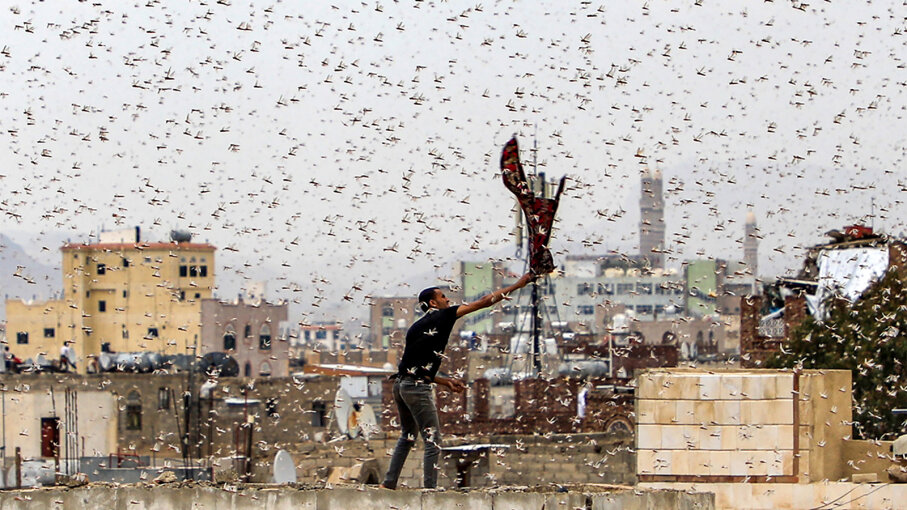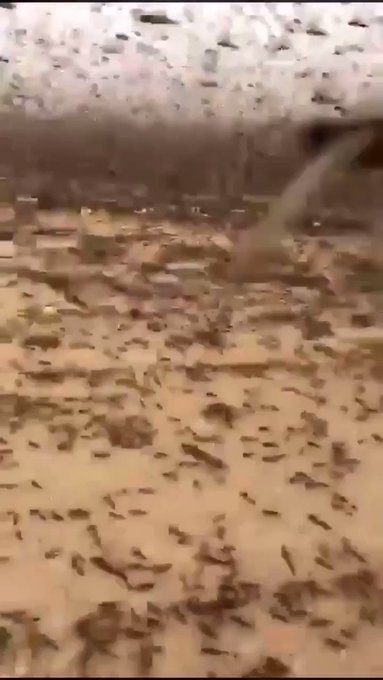 |
| Locusts swarm over the Huthi rebel-held city of Sanaa, the capital of Yemen |
Inside a Locust Plague
Desert
Grasshoppers Gone Wild
BY
JESSLYN SHIELDS
In the ancient world, nobody liked locusts.
Some of the earliest literature produced in
Egypt, China and the Near East describe invasions of the grasshoppers, carried
in on the east wind after the rains.
They could decimate the year's crops in a
matter of hours, bringing famine in their wake.
The desert locust (Schistocerca gregaria)
is a species of grasshopper with breeding and habitat areas extending from West
Africa (Senegal, Mauritania and Morocco), east to the Horn of Africa, the Near
East, and all the way to western India.
They're able to live solitary lives, but
they're also capable of swarming, collecting in large groups and acting in unison
like a school of fish or a pack of dogs.
Physical contact with each other triggers the
instinct to forage for vegetation together, and their bodies actually change as
they do this.
Gregarious desert locusts change color (from
tan to yellow and black) and grow more muscle mass when this happens.
They even start eating toxic plants, which
they would never have done solo.
A swarm of locusts can reach astonishing
sizes: 150 million locusts per 0.3 square miles (1 square kilometer), with a
pack that size eating as much in one day as around 35,000 people.
Because desert locusts eat vegetation,
they've historically been the scourge of anybody who eats plants or grazes
animals in the same general area of the locust swarm.
They're also alarmingly efficient breeders —
between two and five generations of locusts can be produced each year,
depending on weather conditions.
"Unusually good
rains or severe weather events such as cyclones maintain favourable breeding
conditions for up to six months," Keith Cressman, senior locust forecasting
officer for the Food and Agriculture Organization of the United Nations (FAO),
says in an email.
"These
conditions can be sufficient for two generations of breeding, giving rise to
about a 400-fold increase in locusts — a generation is about three months, and
with each generation there is a 20-fold increase in locust numbers."
Modern Locust Plagues
Although locust plagues seem like something
only people during ancient times had to worry about, the 21st century is seeing
its fair share.
However, as 2020 has seen the most
destructive outbreak in 25 years, scientists are examining why locusts are
exploding.
"The short-term
evidence of the past decade indicates an increasing frequency of cyclones in
the Indian Ocean — particularly in the past few years — are to blame," says Cressman.
"In 2019, there
were eight cyclones when normally there are none or only one in a single year.
Cyclones are important because they have caused locust plagues in the past —
the last being in 1967. Therefore, if this trend continues, then it is likely
there will be increased locust upsurges in the Horn of Africa like we are
witnessing now."
The Toll of the Locusts on Human Livelihood
Desert locust upsurges can affect farmers or
those who raise livestock for their livelihood — that includes between 75 and
80 percent of the population in Ethiopia and Kenya.
Children are often pulled out of school in
order to work protecting family farms from locusts, and locust swarms can lead
to family debt: 60 percent of the heads of household in Mauritania in Northwest
Africa went into personal debt due to the locust swarms there between 2003 and
2005, according to Cressman.
Not only that, locust outbreaks can lead to
food insecurity.
Because they love to eat pretty much the same
things people like, locusts can decimate grain crops.
They also eat the same forage cattle eat, so
milk production of grazing animals declines when locusts really get going,
which can affect nutrition in everyone — especially children.
What Governments Can Do About Locusts
All sorts of ideas have been floated — one
has to do with releasing a bunch of ducks into the most locust-ravaged areas,
since the water birds love locusts and will eat over 200 per day.
In the past, farmers have burned tires as a
means of dispersing the locusts, and sprayed pesticides from the ground and
air.
But what's to be done if this starts
happening more frequently due to the environmental effects of climate change?
"In the long
term, strong national locust units must be established and maintained within
the Ministry of Agriculture that have an autonomous budget, equipment,
resources and well-trained staff to monitor the situation and take preventive
measures to avoid emergency situations and upsurges," says Cressman.
"If these units
are not autonomous, too often the funds, staff and equipment are used for other
pest control and then when the desert locust invades, there are insufficient
means."
NOW THAT'S INTERESTING
Locusts were one of the 10 plagues that
visited Egypt in the biblical Book of Exodus — the others were hail, fire,
frogs, lice, livestock diseases, darkness, boils, the death of firstborn sons
and all water turning to blood.
Jesslyn
Shields
is a freelance science writer working out of Athens, Georgia. She writes about
brand new research for HowStuffWorks. Since 2010, Jesslyn's written science
news and content for educational videos, because she loves to always have
something new to yammer on about at parties. You can find her online at www.jesslynshields.com
https://animals.howstuffworks.com/insects/locust-plague.htm

You might also like:
CLICK HERE . . . to view . . .
................................................................................................................................................
CLICK HERE . . . to view . . .
................................................................................................................................................
there was no way to stop them when they hit
CLICK HERE . . . to view . . .




No comments:
Post a Comment